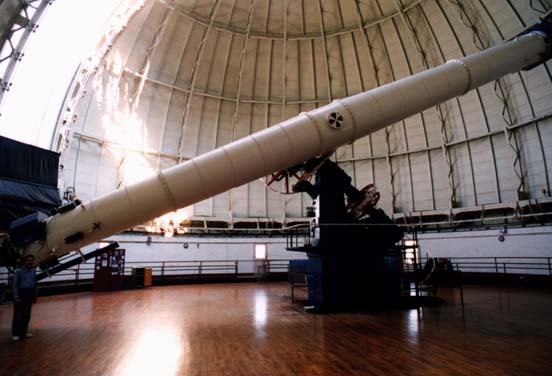| refractors |
|
A refractor focuses the light from an astronomical source using a lens, known as the objective. Galileo's telescope, for example, was a refractor. A photograph of a replica of Galileo's refractor alongside a modern-day equivalent is shown in figure 5.
| figure 5: |
Photograph showing a replica of Galileo's refractor alongside a modern-day
equivalent.
|

The objective lens is usually made of glass and in its simplest form has a bi-convex shape where both surfaces are sections of a sphere. The lens collects the parallel light from an astronomical source and forms an image of it, as shown in figure 6.
| figure 6: |
Schematic of a simple refracting telescope, illustrating the effect of
chromatic aberration.
|
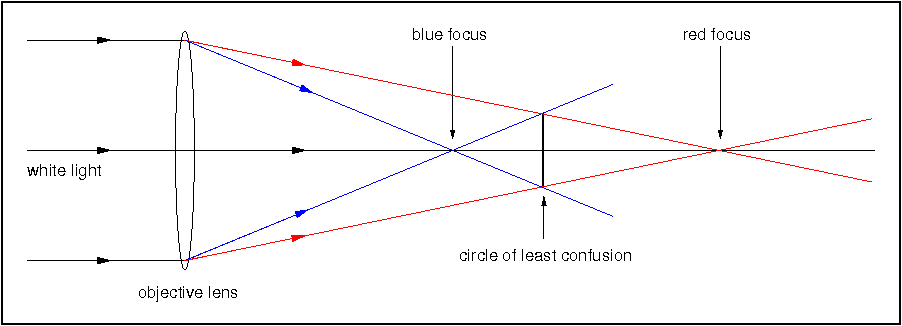
Unfortunately, the image produced by a simple refractor suffers from a major defect, known as chromatic aberration. This aberration is the largest to affect astronomical telescopes. Chromatic aberration arises because the glasses used to make lenses typically have refractive indices which decrease as the wavelength of light increases, resulting in the focal length of the objective increasing as the wavelength increases. Hence there is no single focal plane in which light of all wavelengths from a star is in focus, as shown in figure 6. Moving the focal plane towards the lens will provide a point-like blue image surrounded by a red halo. Similarly, moving the focal plane away from the lens will result in a point-like red image surrounded by a blue halo, as shown in figure 7.
| figure 7: |
Photograph
of the Lagoon Nebula, showing the blue halos due to chromatic
aberration. The bright star at the top is probably quite red, and
hence lacks a halo.
|
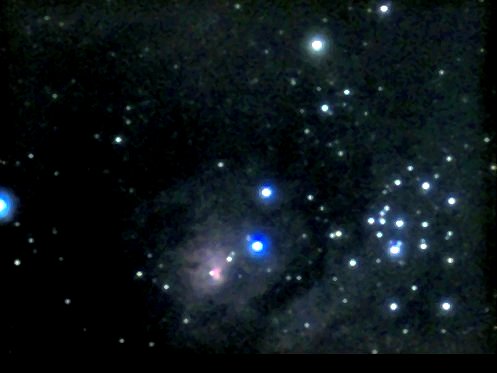
It is possible to minimise the effects of chromatic aberration in a given telescope by positioning the focal plane between these two extremes. The resulting image is known as the circle of least confusion and its position is shown in figure 6. It is the point of best focus, where the image of a star would appear as a filled circle. This is still a relatively poor image, however, and for a long time it was believed to be impossible to correct chromatic aberration any further. Then, in 1758, the English optician John Dolland patented the achromatic doublet (or achromat). The achromat is able to eliminate dispersion, i.e. the fact that each colour is deviated by a different amount, whilst remaining convergent. It does this by using two lenses made of different materials, typically crown and flint glass. The positive crown-glass lens strongly converges the light, but also disperses it. A less-powerful negative flint-glass lens is thus cemented to it which has a higher dispersion (i.e. exhibits a larger spread in refractive index with wavelength) and is able to undisperse the light without completely negating the overall convergence of the beam. The situation is shown schematically in figure 8.
| figure 8: |
Schematic showing how an achromatic doublet can correct for chromatic
aberration by bringing light of different colours to the same focus.
|
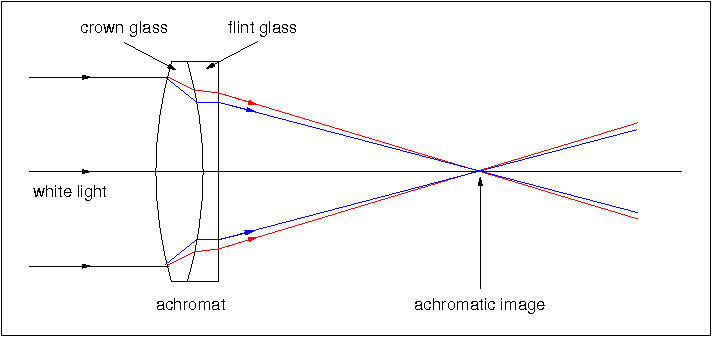
An achromatic doublet can only make the focus the same for two wavelengths and there is residual chromatic aberration at intermediate wavelengths. Nevertheless, achromats deliver order-of-magnitude reductions in chromatic aberration. Further improvement is possible by adding a third lens. These are called apochromats, and they can bring three wavelengths (e.g. red, green and blue) to the same focus. Even greater improvements can be obtained by adding more lenses, so-called super-apochromats, but these become economically unviable for the large apertures required for telescope objectives. An example of a top-of-the-range 4-inch (100mm) apochromatic refractor for the amateur market, costing about £3,000, is shown in figure 9.
| figure 9: |
The 4-inch Takahashi FSQ-106 apochromatic refractor.
|
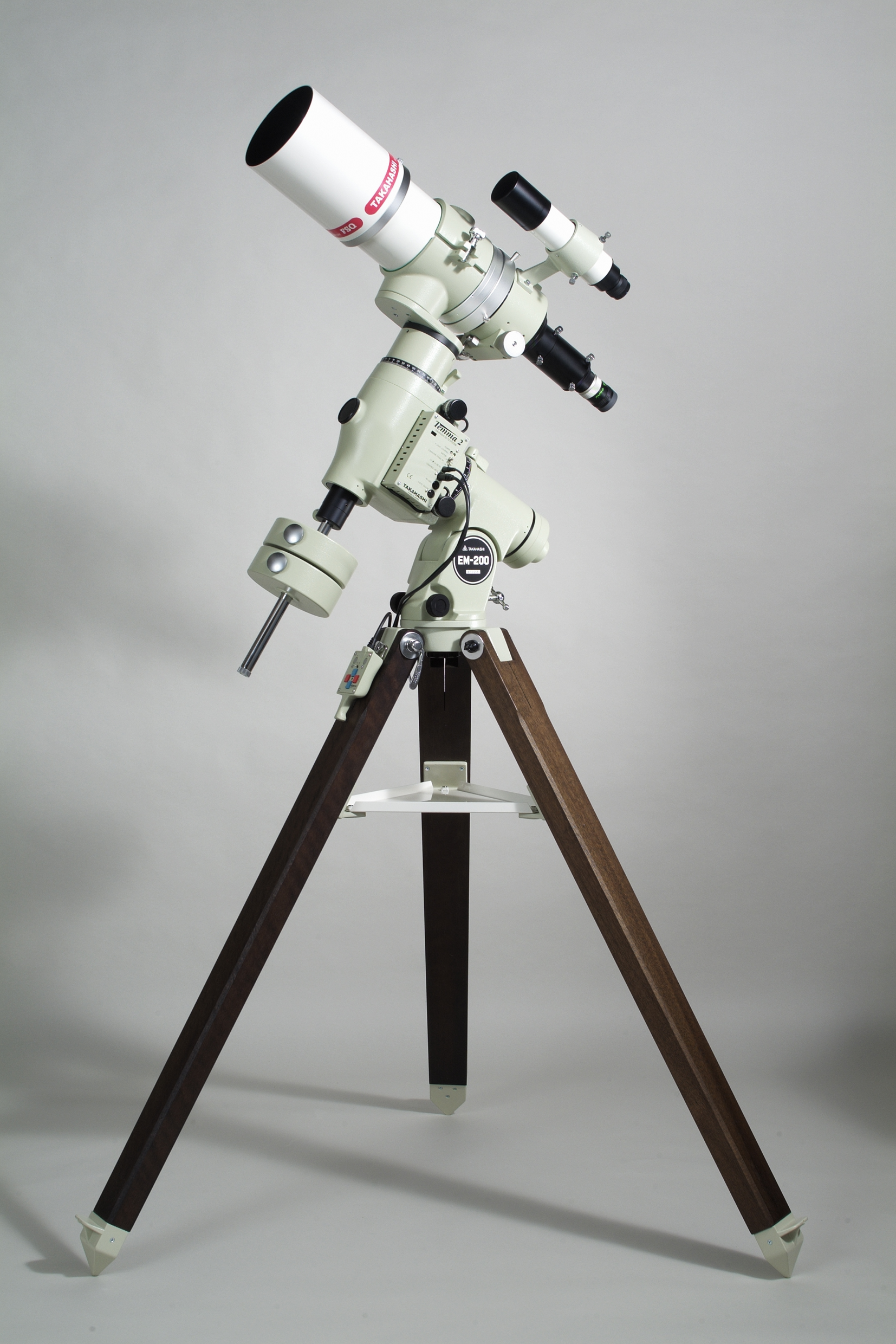
One implication of using achromats to minimise aberrations is that the focal length becomes quite long. Hence refracting telescopes are generally quite slow, with typical focal ratios of about 20. The plate scale is therefore quite small, which spreads the image of a point source over a large area in the focal plane. This makes refractors unsuitable for faint objects, but ideal for planetary observations and astrometry (i.e. measuring the positions of stars).
Refractors are relatively stable against changes in temperature during the course of a night, as changes in the optical properties of the front surface of the objective lens due to expansion/contraction tend to be cancelled out by the back surface. The sealed tube and use of a lens (rather than a mirror) also mean that refractors tend to require little maintenance and hence are optically relatively stable. Despite these advantages, modern professional telescopes are all reflectors. This is due to the cost of making large apochromatic lenses (and even then, there is still some residual chromatic aberration) and the length of the tube required to accommodate the long focal length of the objective (which has a knock-on effect on the size and cost of the dome). The most important reasons of all, however, are insurmountable: first, the lens in a refractor has to be held by its edge, and as the lens becomes larger it starts sagging under its own weight and hence distorts the image; second, as the diameter of the lens increases, so does its thickness and thus so does the amount of light absorbed in the glass. As a result, the largest refractor currently in existence is the 40-inch (1m) telescope at Yerkes Observatory near Chicago, built in 1897. Figure 10 shows the immense scale of the telescope tube and dome - it is unlikely that a bigger refractor will ever be built.
| figure 10: |
A photograph
of the 40-inch, f/19 Yerkes refractor.
|
